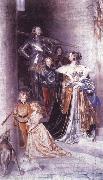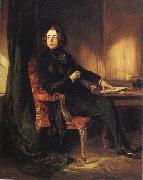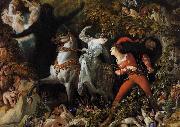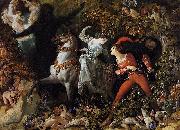Maclise, DanielIrish Painter, 1806-1870 | |||
 |
|||
|
|
|
||||||||||
|
|
||||||||||
|
The Meeting of Wellington and Blucher at Waterloo La Reunión de Wellington y Blucher en Waterloo Pintura Identificación:: 28166 Vea nuestra galería en Suecia |
La Reunión de Wellington y Blucher en Waterloo 1859-61 waterglas on plaster 3.7 x 13.9 m(12ft x 45ft 8in) Royal Gallery Palace of Westminster,London (mk63) 1859-61 waterglas en el yeso 3,7 X 13,9 X 45 p 8 en) Palacio Real de Galería de Westminster, Londres (mk63) 1859-61 waterglas_on_plaster 3.7_x_13.9_m(12ft_x_45ft_8in) Royal_Gallery_Palace_of_Westminster,London_(mk63) |
|||||||||
|
|
||||||||||
|
Sir Francis Sykes and Family Señor Francis Sykes y la Familia Pintura Identificación:: 28184 Vea nuestra galería en Suecia |
Señor Francis Sykes y la Familia 1837 watercolour 112.3 x 64.7 cm (44 1/2 x 25 1/2 in)Private collection (mk63) 1837 acuarela 112,3 X 64,7 cm (44 1/2 X 25 1/2 en) la colección Privada (mk63) 1837 watercolour_112.3_x_64.7_cm (44_1/2_x_25_1/2_in)Private_collection_(mk63) |
|||||||||
|
|
||||||||||
|
Charles Dickens Charles Dickens Pintura Identificación:: 28186 Vea nuestra galería en Suecia |
Charles Dickens 1839 Oil on canvas 91.4 x 71.4cm (36 x 28 1/8 in) National Portrait Gallery London (mk63) 1839 Petróleo en la lona 91,4 X 71.4cm (36 X 28 1/8 en)Galería iconográfica Nacional Londres (mk63) 1839 Oil_on_canvas_91.4_x_71.4cm (36_x_28_1/8_in) National_Portrait_Gallery_London_(mk63) |
|||||||||
|
|
||||||||||
|
A Scene from Pintura Identificación:: 62827 Vea nuestra galería en Suecia |
A Scene from 45 x 61 cm Royal Collection, Windsor The subject is based on a moment in a romantic German novel entitled Undine, written by Friedrich de la Motte Fouque which was first translated into English in 1818 and became almost as popular with artists in England as Goethe's Faust. The incident painted by Maclise occurs in chapter IX, where the young knight, Huldbrand, accompanies his bride, Undine, back home through the forest. The priest, Father Heilmann, who has just performed the marriage ceremony, follows behind and is visible beneath the branch of the tree. Ahead is the dark and sinister apparition, Kuhleborn, the spirit of the waters and the uncle of Undine. Huldbrand draws his sword on Kuhleborn and then strikes him, whereupon the spirit of the waters is transformed into a waterfall. Clearly the painting illustrates the forces of good, represented by the newly married couple, overcoming the power of evil, symbolised by the looming figure of the water god. The narrative element of the picture is aligned on a diagonal, which is contained within a bower populated by elves, goblins and water-nymphs associated with the surrounding forest. The composition is a triumph of design with the main elements of the story formed by an ornamental border of considerable intricacy. Maclise used other such borders for several of his book illustrations including those for The Chimes by Charles Dickens of 1844 and Irish Melodies by Thomas Moore of 1845. Maclise has here relied on German sources for the decorative features, and was clearly influenced by German illustrators. Maclise was of Irish origin and in 1827 he came to London, where he almost immediately gained recognition as a portrait draughtsman, drawing numerous likenesses for Eraser's Magazine. He painted historical and literary subjects, several as frescoes for the Palace of Westminster. Maclise formed close friendships with the novelists Charles Dickens and William Makepeace Thackeray as well as his compatriot, the poet Thomas Moore, and the politician Benjamin Disraeli. With all of these he shared an ebullience of character and a sense of humour, but this later gave way to melancholy and pessimism 45_x_61_cm_Royal_Collection,_Windsor_The_subject_is_based_on_a_moment_in_a_romantic_German_novel_entitled_Undine,_written_by_Friedrich_de_la_Motte_Fouque_which_was_first_translated_into_English_in_1818_and_became_almost_as_popular_with_artists_in_England_as_Goethe's_Faust._The_incident_painted_by_Maclise_occurs_in_chapter_IX,_where_the_young_knight,_Huldbrand,_accompanies_his_bride,_Undine,_back_home_through_the_forest._The_priest,_Father_Heilmann,_who_has_just_performed_the_marriage_ceremony,_follows_behind_and_is_visible_beneath_the_branch_of_the_tree._Ahead_is_the_dark_and_sinister_apparition,_Kuhleborn,_the_spirit_of_the_waters_and_the_uncle_of_Undine._Huldbrand_draws_his_sword_on_Kuhleborn_and_then_strikes_him,_whereupon_the_spirit_of_the_waters_is_transformed_into_a_waterfall._Clearly_the_painting_illustrates_the_forces_of_good,_represented_by_the_newly_married_couple,_overcoming_the_power_of_evil,_symbolised_by_the_looming_figure_of_the_water_god._The_narrative_element_of_the_picture_is_aligned_on_a_diagonal,_which_is_contained_within_a_bower_populated_by_elves,_goblins_and_water-nymphs_associated_with_the_surrounding_forest._The_composition_is_a_triumph_of_design_with_the_main_elements_of_the_story_formed_by_an_ornamental_border_of_considerable_intricacy._Maclise_used_other_such_borders_for_several_of_his_book_illustrations_including_those_for_The_Chimes_by_Charles_Dickens_of_1844_and_Irish_Melodies_by_Thomas_Moore_of_1845._Maclise_has_here_relied_on_German_sources_for_the_decorative_features,_and_was_clearly_influenced_by_German_illustrators._Maclise_was_of_Irish_origin_and_in_1827_he_came_to_London,_where_he_almost_immediately_gained_recognition_as_a_portrait_draughtsman,_drawing_numerous_likenesses_for_Eraser's_Magazine._He_painted_historical_and_literary_subjects,_several_as_frescoes_for_the_Palace_of_Westminster._Maclise_formed_close_friendships_with_the_novelists_Charles_Dickens_and_William_Makepeace_Thackeray_as_well_as_his_compatriot,_the_poet_Thomas_Moore,_and_the_politician_Benjamin_Disraeli._With_all_of_these_he_shared_an_ebullience_of_character_and_a_sense_of_humour,_but_this_later_gave_way_to_melancholy_and_pessimism |
|||||||||
|
|
||||||||||
|
A Scene from Undine Pintura Identificación:: 70671 Vea nuestra galería en Suecia |
A Scene from Undine Medium Oil on canvas Dimensions 45 x 61 cm Medium_Oil_on_canvas _ Dimensions_45_x_61_cm |
|||||||||
|
|
||||||||||
| Artista Previo Próximo Artista | ||||||||||
|
|
||||||||||
| Maclise, Daniel | ||||||||||
| Irish Painter, 1806-1870 | ||||||||||
|
|
||||||||||
IntoFineArt Co,.Ltd.













